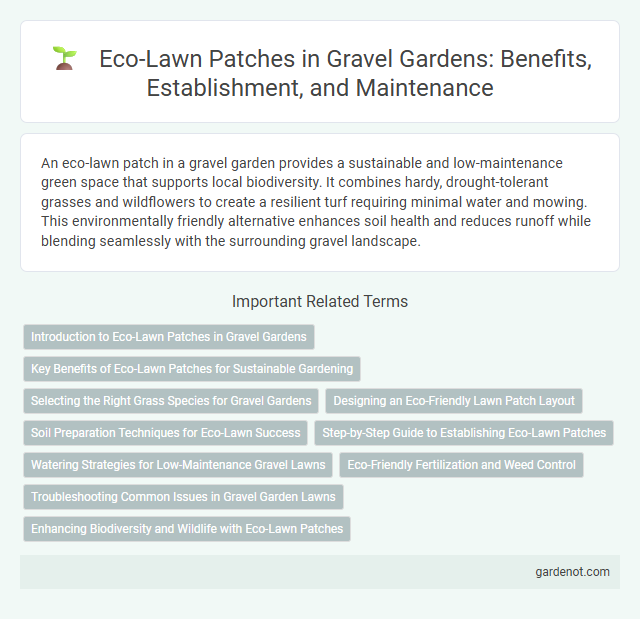An eco-lawn patch in a gravel garden provides a sustainable and low-maintenance green space that supports local biodiversity. It combines hardy, drought-tolerant grasses and wildflowers to create a resilient turf requiring minimal water and mowing. This environmentally friendly alternative enhances soil health and reduces runoff while blending seamlessly with the surrounding gravel landscape.
Introduction to Eco-Lawn Patches in Gravel Gardens
Eco-lawn patches in gravel gardens create sustainable green spaces that thrive with minimal maintenance and water use. These patches utilize drought-resistant grass varieties and native plants to enhance biodiversity and soil health while providing a soft contrast to hard gravel surfaces. Integrating eco-lawn patches supports urban cooling, reduces runoff, and promotes pollinator habitats within gravel landscaping designs.
Key Benefits of Eco-Lawn Patches for Sustainable Gardening
Eco-lawn patches offer a low-maintenance, water-efficient alternative to traditional grass, making them ideal for sustainable gardening by reducing the need for frequent watering and mowing. These patches support biodiversity by providing habitats for pollinators and beneficial insects, contributing to healthier garden ecosystems. Their ability to improve soil health through natural nutrient cycling enhances long-term garden sustainability and reduces reliance on synthetic fertilizers.
Selecting the Right Grass Species for Gravel Gardens
Choosing the right grass species for an eco-lawn patch in gravel gardens involves selecting drought-tolerant, low-maintenance varieties such as Festuca ovina or Bouteloua gracilis. These grasses thrive in well-drained, rocky soils and require minimal watering and mowing, ensuring sustainability and aesthetic appeal. Incorporating native species enhances biodiversity while promoting resilience to local climate conditions in the gravel garden ecosystem.
Designing an Eco-Friendly Lawn Patch Layout
Designing an eco-friendly lawn patch in a gravel garden involves selecting drought-tolerant, low-maintenance grass species like Buffalo grass or Fine Fescues that thrive with minimal watering and mowing. Incorporating native wildflowers and ground covers such as clover or creeping thyme enhances biodiversity, improves soil health, and reduces the need for chemical fertilizers. Strategically placing permeable pathways and mulch around the eco-lawn patch ensures efficient water drainage and prevents soil compaction, promoting sustainable garden management.
Soil Preparation Techniques for Eco-Lawn Success
Effective soil preparation for eco-lawn patches in gravel gardens involves thorough soil aeration and the incorporation of organic matter to enhance drainage and nutrient retention. Testing soil pH ensures optimal conditions, typically favoring a neutral to slightly acidic range for native grasses and low-maintenance groundcovers. Proper grading and removal of debris prevent waterlogging and support healthy root development essential for sustainable eco-lawn growth.
Step-by-Step Guide to Establishing Eco-Lawn Patches
Establishing eco-lawn patches involves selecting drought-tolerant grass species such as fescue or ryegrass, which thrive in low-maintenance gravel garden environments. Begin by preparing the soil through aeration and adding organic compost to enhance nutrient retention and water permeability. Sow seeds evenly, water gently but consistently during germination, and gradually reduce watering to encourage deep root growth, ensuring a sustainable, resilient lawn patch that supports biodiversity while minimizing water use.
Watering Strategies for Low-Maintenance Gravel Lawns
Eco-lawn patches thrive in gravel gardens by utilizing efficient watering strategies such as drip irrigation and infrequent deep watering to promote deep root growth while conserving water. These low-maintenance gravel lawns benefit from mulching around plants to retain soil moisture and reduce evaporation. Selecting drought-tolerant grass varieties also minimizes watering needs and enhances sustainability in gravel garden landscapes.
Eco-Friendly Fertilization and Weed Control
Eco-lawn patches in gravel gardens thrive through eco-friendly fertilization using organic compost and slow-release natural nutrients that enhance soil health and reduce chemical runoff. Weed control relies on manual removal, mulch application, and selective use of non-toxic herbicides to maintain plant diversity without harming beneficial insects. Employing these sustainable practices preserves the garden's biodiversity and minimizes environmental impact while promoting resilient, lush ground cover.
Troubleshooting Common Issues in Gravel Garden Lawns
Eco-lawn patches in gravel gardens often face issues such as poor drainage, leading to waterlogging and root rot that stunt grass growth. Compacted gravel layers can inhibit root penetration, causing uneven lawn patches and bare spots. Addressing these problems involves improving soil aeration, ensuring proper gravel depth, and maintaining balanced moisture levels to promote healthy lawn development.
Enhancing Biodiversity and Wildlife with Eco-Lawn Patches
Eco-lawn patches in gravel gardens provide a sustainable ground cover that supports local biodiversity by attracting pollinators such as bees and butterflies. These low-maintenance grass blends require minimal watering and mowing, reducing environmental impact while creating a habitat for beneficial insects and small wildlife. Integrating eco-lawn patches enhances soil health, promotes native plant growth, and contributes to a thriving garden ecosystem.
Eco-lawn patch Infographic

 gardenot.com
gardenot.com